| Name | Location | Notes |
| Armenian Monastic Ensembles of Iran | West Azerbaijan Province | Three monastic ensembles of the Armenian Christian religion make up the Armenian Monastic Ensembles of Iran, located in the northwest of the nation: The Chapel of Dzordzor, St. Thaddeus, and St. Stepanos. These buildings—the earliest of which, St. Thaddeus, dated to the seventh century—serve as illustrations of the extraordinary worth of Armenian architectural and decorative traditions over the world. They provide evidence of significant interactions with various local civilizations, particularly Orthodox, Byzantine, and Persian ones. The monasteries served as a significant hub for the diffusion of that culture in the area since they were located on the southern edge of the Armenian cultural realm. |
| Bam and its Cultural Landscape | Kerman Province | The city of Bam is located in a desolate area on the southernmost tip of the Iranian high plateau. The Achaemenid period may be when Bam first appeared (6th to 4th centuries BC). Being at the intersection of crucial trade routes and well-known for producing silk and cotton clothing, its golden age was during the seventh and eleventh centuries. The qanats, or underground irrigation canals, are what gave rise to life in the oasis and Bam has preserved some of the earliest signs of their existence in Iran. Arg-e Bam is the best-known illustration of a fortified medieval town built of mud layers (Chineh). |
| Bisoton | Kermanshah Province | The old trade route that connected Mesopotamia with the Iranian High Plateau runs through Bisotun, which is home to artifacts dating from prehistoric times up to the Median, Achaemenid, Sassanian, and Ilkhanid eras. The cuneiform inscription and bas-relief that Darius I, The Great, commissioned when he ascended to the throne of the Persian Empire in 521 BC serve as the site’s primary monument. The bas-relief shows Darius stepping on the chest of a man who is lying on his back in front of him while clutching a bow as a symbol of his authority. The figure is said to be a representation of Gaumata, a contender to the throne and Median magus, whose death paved the way for Darius’ ascent to power. |
| Cultural Landscape of Maymand | Kerman Province | At the southernmost point of Iran’s central highlands, in a valley, lies a self-contained, semi-arid region known as Maymand. Agro-pastoralist villagers live in a semi-nomadic lifestyle. Living in transitory villages in the spring and fall, they rear their livestock on mountain meadows. They reside in cave homes cut out of soft rock (kamar) during the winter months deeper down the valley, which is a unique type of living in a dry, arid region. This cultural landscape is an illustration of a system that incorporates the movement of humans rather than animals and appears to have been more ubiquitous in the past. |
| Cultural Landscape of Hawraman/Uramanat | Kurdistan Province | The remote and rugged environment of the region, which has been inhabited by the Hawrami people, an agropastoral Kurdish tribe, dates back to around 3000 BCE. The property is split into two sections: the Central-Eastern Valley (Zhaverud and Takht in Kurdistan Province), and the Western Valley. It is situated in the Iranian provinces of Kurdistan and Kermanshah near the country’s western border (Lahun, in Kermanshah Province). Human habitation in these two valleys has changed over millennia to accommodate the difficult alpine environment. |
| Gonbad-e Qābus | Golestan Province | A testament to the cultural contact between Central Asian nomads and the ancient Iranian civilization is the 53 m-high mausoleum that was constructed in 1006 for Qbus ibn Voshmgir, a Ziyarid monarch and literati, close to the remains of the ancient city of Jorjan in north-east Iran. The tower is all that is left of Jorjan, a great epicenter of the arts and sciences that was devastated in the 14th and 15th centuries by the Mongol invasion. It is a superb and highly advanced illustration of Islamic architecture that had an impact on the construction of temples in Iran, Anatolia, and Central Asia. |
| Golestan Palace | Tehran | A prime example of the Qajar era’s masterful fusion of traditional Persian arts and architecture with Western influences is the opulent Golestan Palace. The Qajar family, who came to power in 1779 and established Teheran as the nation’s capital, established their seat of administration in the walled Palace, one of Teheran’s oldest sets of structures. The Palace’s most distinguishing elements and lavish ornamentation come from the 19th century and are built around a park with lakes and cultivated areas. It developed into a hub for Qajari arts and architecture, of which it is an exceptional example, and it continues to this day to serve as a source of inspiration for Iranian artists and architects. |
| Lut Desert | Kerman and Sistan and Baluchestan Provinces | In the southeast of the nation is where you’ll find Dasht-e-Lut, also known as the Lut Desert. Strong winds sweep through this dry subtropical region between June and October, carrying silt and causing massive aeolian erosion. As a result, the location offers some of the most impressive examples of aeolian yardang landforms (massive corrugated ridges). Additionally, there are significant rocky deserts and dune areas there. The property serves as an outstanding illustration of current geological processes. |
| Sassanid Archaeological Landscape in the Fars Region | Fars Province | The three geographical regions of Bishapur, Firuzabad, and Sarvestan, in the southeast of Fars Province, are home to eight archaeological sites. The Sassanian Empire, which ruled over the area from 224 to 658 CE, left behind fortified buildings, palaces, and city layouts that may be found today. A city and architectural structures from Shapur I’s successor, Ardashir Papakan, as well as the capital established by the dynasty’s founder, Ardashir Papakan, are all included in this list of locations. |
| Masjed-e Jāmé of Isfahan | Isfahan, Isfahan Province | The Masjed-e Jmé (or “Friday mosque”), which is situated in Isfahan’s old district, serves as a remarkable example of how mosque construction has changed over the course of twelve centuries, beginning in AD 841. It is the first building of its kind still standing in Iran and served as a model for later mosque construction in Central Asia. The complex, which has a surface area of more than 20,000 m2, is also the first Islamic structure to adapt the Sassanid palaces’ four-courtyard design for use in Islamic religious construction. Its double-shelled ribbed domes are an example of innovative architecture that motivated builders in the area. |
| Naqsh-e Jahan Square | Isfahan, Isfahan Province | The majestic Portico of Qaysariyyeh, the Mosque of Sheykh Lotfollah, the Royal Mosque, and the Timurid palace from the 15th century are all features of the site, which Shah Abbas I the Great built at the start of the 17th century. It is flanked by grand structures on all sides, which are connected by a network of two-story arcades. They offer an impressive example of the complexity of Persia’s social and cultural life at the time. |
| Pasargadae | Fars Province | Cyrus II the Great established Pasargadae, the first dynasty capital of the Achaemenid Empire, on Pars, the Persians’ ancestral home, in the sixth century BC. Three very noteworthy remnants in the 160-ha complex include the Mausoleum of Cyrus II, a fortified terrace, Tall-e Takht, and a royal ensemble with a beautiful gatehouse, audience hall, residential palace, and gardens. The first significant multicultural empire in Western Asia had its capital at Pasargadae. It is regarded as the first empire to appreciate the cultural variety of its various peoples, spanning the Eastern Mediterranean, Egypt, and the Hindus River. This was reflected in Achaemenid architecture, which was a synthesis of several civilizations. |
| Persepolis | Fars Province | Persepolis, which Darius I built in 518 B.C., served as the seat of the Achaemenid Empire. |
| Shahr-i Sokhta | Sistan and Baluchestan Province | A place called Shahr-i Sokhta, which means “Burnt City,” is where old trade routes that cross the Iranian plateau converge. Ruins of the mudbrick city depict the earliest advanced cultures in eastern Iran. It was founded circa 3200 BC and inhabited for four major eras up to 1800 BC, during which time the city’s several different neighborhoods grew. |
| Sheikh Safi al-din Khānegāh and Shrine Ensemble in Ardabil | Ardabil Province | This Sufi sanctuary was built between the early 16th and the late 18th centuries, making the most of the space available by employing Iranian traditional architectural forms to suit a variety of purposes (including mausoleums, kitchens, a mosque, a library, a cistern, a bakery, a school, a hospital, and some offices). There are eight gates that represent the eight Sufi attitudes, as well as a route that leads to the Sheikh’s shrine that is separated into seven portions that represent the seven stages of Sufi mysticism. |
| Shushtar Historical Hydraulic System | Khuzestan Province | Darius the Great, who reigned in the fifth century B.C., is credited with creating the Shushtar, Historical Hydraulic System, which has been recognized as a marvel of artistic brilliance. For water diversion on the Kârun River, it was necessary to construct two sizable canals, one of which, the Gargar Canal, is still in use today and supplies water to the city of Shushtar via a system of tunnels that feed mills. It creates a stunning cliff from which water flows into a pool down below. After there, it enters the plain to the south of the city, where it has made it possible to cultivate 40,000 acres of orchards and farmland called Mianâb (Paradise). |
| Soltaniyeh | Zanjan Province | Oljaytu’s mausoleum was constructed at Soltaniyeh, the Ilkhanid dynasty’s capital city established by the Mongols and completed in 1302-12. The province of Zanjan’s Soltaniyeh is an important example of Persian architecture’s achievements and a key structure in the development of its Islamic architecture. The octagonal structure has eight thin minarets surrounding it and a 50 m tall dome made of turquoise-blue faience on top. It is the earliest double-shelled dome still in existence in Iran. |
| Susa | Khuzestan Province | The property includes Ardeshir’s palace on the opposite bank of the Shavur River as well as a collection of archaeological mounds rising on the eastern side of the river, all of which are situated in the lower Zagros Mountains in southwest of Iran. Administrative, residential, and palace buildings are among the architectural monuments that have been unearthed. Susa is made up of many tiers of layered urban settlements that date from the late fifth millennium BCE to the thirteenth century CE. The area is a great example of the Parthian, Persian, and Elamite cultural traditions that were once prevalent. |
| Tabriz Historic Bazaar Complex | East Azerbaijan Province | The medieval bazaar complex in Tabriz is one of the most important Silk Road commercial sites. Tabriz has always been a center for cultural exchange. The Tabriz Historic Bazaar Complex consists of several interconnected, covered brick structures, enclosed spaces, and buildings for diverse functions. The town of Tabriz and its Bazaar were already prosperous and well-known when it was decided to make it the capital city of the Safavid kingdom in the 13th century. Tabriz is located in Eastern Azerbaijan. |
| Takht-e Soleyman | West Azerbaijan Province | In the volcanic mountain range of northwest Iran, a valley contains the Takht-e Soleyman ancient site. The site has the primary Zoroastrian shrine as well as a Sasanian temple dedicated to Anahita that was largely rebuilt during the Ilkhanid (Mongol) era (13th century) (6th and 7th centuries). The place has a lot of symbolic meaning. Islamic architecture changed significantly as a result of the layout, palace, and fire temple designs. |
| Tchogha Zanbil | Khuzestan Province | The sacred city of the Kingdom of Elam’s ruins, which are ringed by three gigantic concentric walls, is located near Tchogha Zanbil. The thousands of worthless bricks left behind following Ashurbanipal’s siege on the city, which was built around 1250 B.C., show that it was abandoned unfinished. This is one of Iran’s historical places that needs to be visited. |
| The Persian Garden | Many Provinces (Fars, Kerman, Razavi Khorasan, Yazd, Mazandaran, and Isfahan Provinces) | Nine gardens in as many provinces are part of the property. They provide an illustration of the range of Persian garden designs that have evolved and adapted to meet varied climatic conditions while maintaining essential concepts that date back to the time of Cyrus the Great’s rule in the sixth century BC. The four Zoroastrian elements—heaven, earth, water, and plants—as well as Eden were intended to be represented in the Persian garden. Water was used extensively for irrigation and decoration in the four distinct areas that made up the Persian garden. In addition to intricate irrigation systems, these gardens, which have been there since the sixth century BC, also include buildings like pavilions, walls, and cottages. |
| Trans-Iranian Railway | Mazandaran, Tehran , and Khuzestan Provinces | The Trans-Iranian Railway runs across two mountain ranges, rivers, hills, forests, and plains, as well as four distinct climatic regions, to connect the Persian Gulf in the southwest with the Caspian Sea in the northeast. The 1,394-kilometer-long railway was successfully designed and constructed during the course of a 1927–1938 cooperation between the Iranian government and 43 construction firms from various countries. The railway is well-known for both its size and the technical prowess required to navigate barriers including steep terrain and other difficulties. |
| Persian Qanat | Razavi Khorasan, South Khorasan, Yazd, Kerman, Markazi and Isfahan Provinces | The archaic qanat system, which includes extracting water from alluvial aquifers at valley crests and transferring it via underground tubes by gravity for lengths that can be many kilometers, supplies agriculture and permanent communities throughout Iran’s dry regions. The eleven qanats of this system have watermills, staff rest areas, and water reservoirs. The ancient communal management system that is still in operation allows for the equitable and sustainable sharing and distribution of water. The qanats provide exceptional proof of cultural customs and civilizations in arid, desert areas. It is one of the most beautiful historical places in Iran. |
| Historic City of Yazd | Yazd, Yazd Province | 270 kilometers southeast of Isfahan, in the center of the Iranian plateau, close to the Silk and Spice Roads, is where you’ll find Yazd. It serves as a tangible example of how desert existence necessitates the utilization of few resources. A qanat system created to extract water from beneath provides water to the city. Yazd’s traditional districts, the qanat system, traditional hammams, bazaars, homes, mosques, Zoroastrian temples, synagogues, and the ancient garden of Dolat-Abad have all survived modernity that has devastated many other old clay cities. |
Ali Qapu Palace, Isfahan
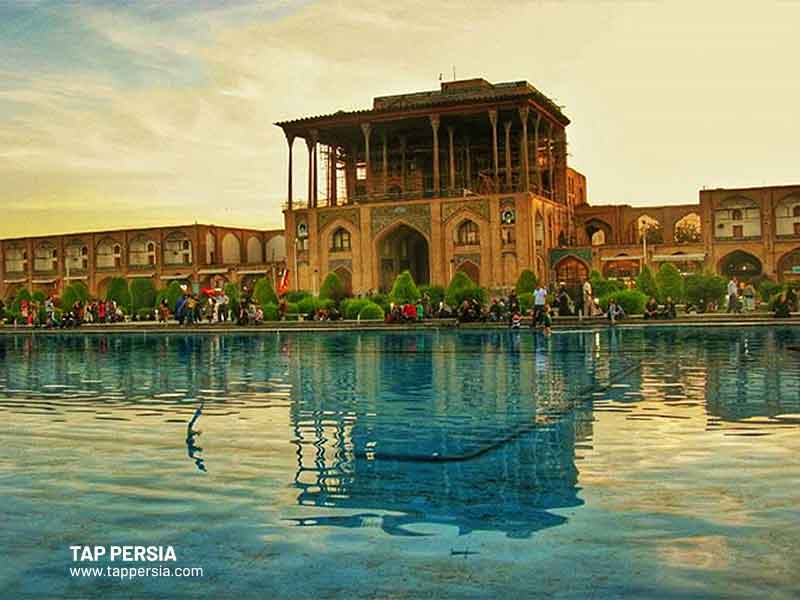
One of the most significant architectural marvels from the early 11th century AH with a stellar international reputation is a house that is located to the west of Naghsh-e Jahan Square and directly across from Sheikh Lotfoallah Mosque. Shah Abbas the First commissioned the building of this palace, which is a rare example of Safavid palace architecture when the capital was shifted from Qazvin to Isfahan in the early 11th century AH (between 1225 and 1231 AD).
This palace is one of the popular historical places in Iran. It was made into one of the most spectacular Safavid monuments thanks to Reza Abbasi’s miniature paintings of Ali Qapu (Isfahan historical places). Its beauty was further increased by the skilled stucco work on the last floor of the palace, whose chamber is known as the “Music Room” or “Sound Room.” In addition to controlling sound, stucco also prevents reflection.
Nasir-ol-Molk Mosque, Shiraz
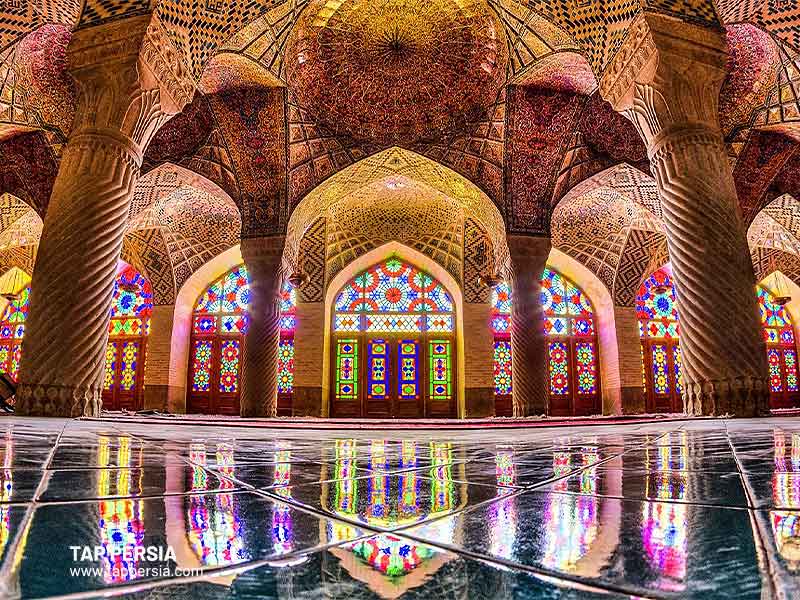
In terms of tilework and Muqarnas, the Nasir-ol-Molk Mosque is among Iran’s most exquisite mosques. The mosque is exquisitely beautiful thanks to the way light and color interact. It is Shiraz’s most exquisite mosque. Every traveler longs to see this historical place in Iran with its vibrant windows, soaring ceilings, and exquisite tilework.
Nasir-ol-Molk Mosque is the most valuable mosque in Iran in terms of tilework, and it is a one-of-a-kind mosque in terms of structure, particularly tilework and Muqarnas(Shiraz historical places). It is the only mosque in Iran that can compete in terms of color with the Al-Aqsa Mosque and the Blue Mosque in Istanbul.
Golestan Palace, Tehran

Tehran’s Golestan Palace is home to a variety of historically significant structures that date from various eras. Salam Hall, Mirror Hall, Dining Hall, Karimkhani Privacy, Badgir Mansion, Berlian Hall, Diamond Hall, Shams Al-Amara Palace, and Abyaz Palace are only a few of the palace’s several parts. The oldest structures in the Golestan complex are the marble throne porch and Karimkhani seclusion, which date to the reign of Karim Khan Zand(Tehran historical places).
The Golestan Palace, which has a history of more than 440 years and dates back to the Qajar dynasty, is one of Tehran province’s most well-known attractions in the city. The current size of Golestan Palace, which was home to rulers including Agha Mohammad Khan, Muzaffar al-Din Shah, Nasser al-Din Shah, Fath Ali Shah, and Ahmad Shah Qajar, is 4.5 hectares, which is the twelfth size of its original territory.
Persepolis, Shiraz
One of the most well-known historical sites among the Persian people is Persepolis because of the splendor and beauty of the remnants of the enormous monuments there. Persepolis, which lies 60 kilometers northeast of Shiraz, served as the seat of the Achaemenid Empire’s ruler, Darius, who built the city in 518 B.C. Despite the fact that Alexander the Great set fire to a great amount of the city, it is the ideal location to learn more about Persian civilization.
Because of its unique archeological features, Persepolis is included as a UNESCO World Heritage Site. Iranians refer to it as Takht-e Jamshid, which is Persian for “the throne of Jamshid,” one of the earliest rulers to rule over Persia, according to tradition. Iranians are proud of this historical place just like other famous historical places in Iran.
Earth City of Yazd
In the old earthen city of Yazd, life has been adapted to its desert environment, most notably through the qanats’ water supply. Yazd, a city on the Silk and Spice Roads, has a lengthy history that dates back to the Achaemenid dynasty. Yazd is one of the oldest cities on earth, with its many badgirs (wind towers) soaring above a maze of adobe rooftops.
10% of the population of Yazd, which was first inhabited 5000 years ago, practice the pre-Islamic religion of Zoroastrianism. An everlasting flame is protected by a beautiful ateshkadeh (fire temple) that welcomes guests. Over here you can check out one of the most fascinating historical places of Iran.
Naqsh-e Rustam Necropolis, Shiraz
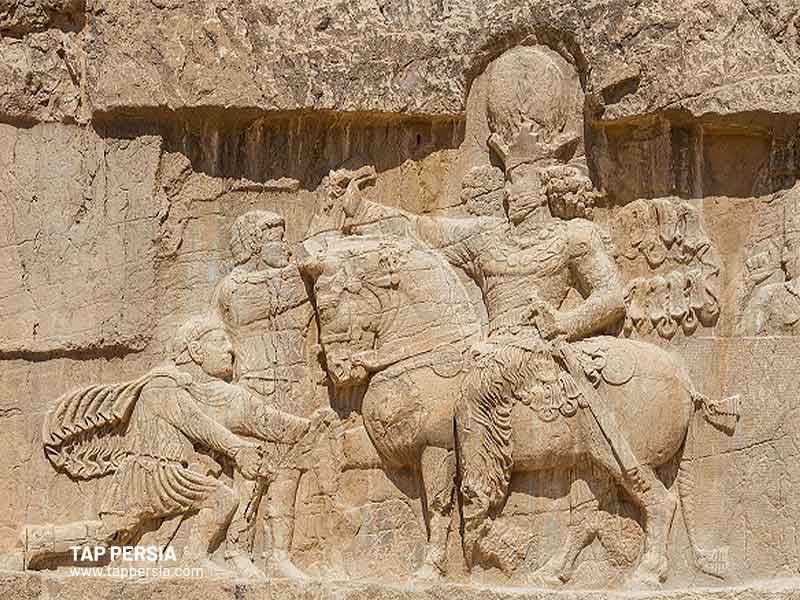
For those who are interested in Iran historical places and the development of human civilization in general, this is a priceless resource. You may learn about three distinct prehistoric eras, beginning with the history of the Elam civilization, which existed between 600 and 2000 B.C. The necropolis, which is made up of the graves of four Achaemenid monarchs, is the next stop on your historical tour.
These tombs are artifacts from the Achaemenid Empire (330–600 B.C.), which were skillfully carved on tall cliffs and decorated with stunning reliefs. Behind these cliffs is a strange, 12.5 m-tall building with no windows and an entryway. This strange building, known as Ka’ba-ye Zartosht, has a lengthy inscription by Kartir from the Sassanid era exactly at the bottom of it.
One of Naqsh-e Rostam’s most significant historical sites is the tomb of Darius the Great, who is revered by Iranians as a great ruler.
Qavam House, Shiraz

During the late 19th-century Qajar era, the Qavam House was constructed. The Qavam family was one of Shiraz’s prominent political families at the period, and the Qavam House served as both their home and administrative headquarters. People often refer to the garden as Narenjestan or the orange garden since it is overrun with sour orange trees.
The complex of Narenjestan is separated into two parts: south and north. As soon as guests enter the garden and move ahead, their eyes are drawn to the Narenjestan monument, which is the garden’s most attractive feature. The Qavam House is one of the finest historical places in Iran.
Tower of Silence, Yazd

It is nearly difficult to plan a trip to Iran and leave Yazd off of the itinerary. This medieval city is regarded as a “must-see” location in Iran by both domestic and foreign tourists because of its intact earthen architecture, mud-brick homes, astounding old monuments, and the extraordinary cooling mechanism that is accomplished by the wind catchers (also known as Baadgir).
In addition, Yazd has a large number of synagogues, mosques, and Zoroastrian temples because it was a religiously diverse city for many years. The city of Yazd is one of Iran’s historical places that need visiting(tower of silence).
Khaju Bridge, Isfahan
On the eastern side of Si-o-Seh Pol and the Zayanderud River is where you’ll find Isfahan’s Khaju Bridge. The present Khaju Bridge was constructed to the right of Shah Abbas II in 1060, however, its foundations date back to the late Timuri period.
This beautiful bridge is 12 meters in width and 133 meters in length. During the Safavid era, it was viewed more as a dam and was more recognized than other Zayanderud bridges for its architecture and tile work decorations. The monument was constructed using materials including bricks, cement, and stones. The look of Khaju Bridge is somewhat comparable to that of Allah Verdi Khan Bridge. Tourists will love this Iranian historical place.
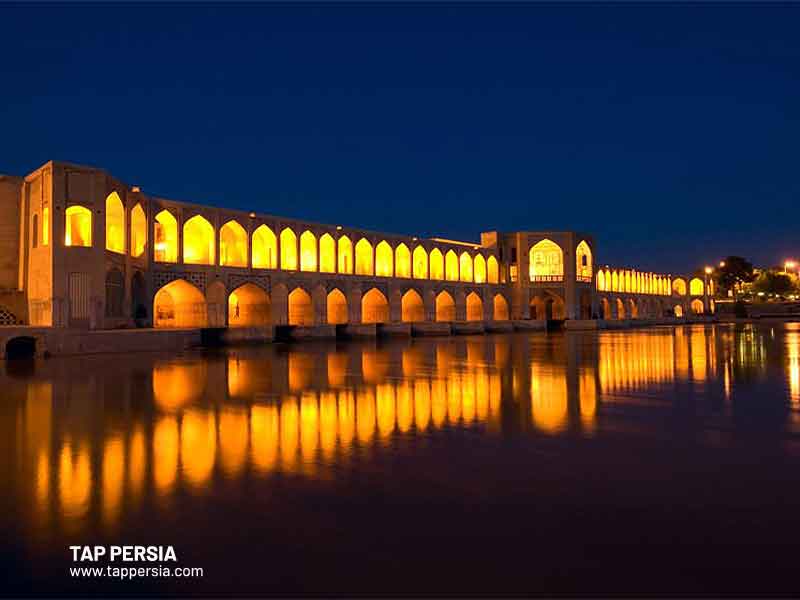
Tabriz Historic Bazaar Complex
Since ancient times, Tabriz has been a center for cultural exchange, and one of the most important Silk Road commercial centers is the old market complex. The Tabriz Historic Bazaar Complex consists of several interconnected, covered brick structures, enclosed spaces, and buildings for diverse functions. The town of Tabriz and its Bazaar were already prosperous and well-known when it was decided to make it the capital city of the Safavid kingdom in the 13th century (Iran bazaar).
The city lost its significance as the nation’s capital in the 16th century, but as Ottoman rule grew, it continued to play a vital role as a commercial hub until the end of the 18th century. This historical place of Iran is a must-see for tourists.
Armenian Monastic Ensembles of Iran
The complex of Armenian churches, a few nearby structures, and Dare Sham Village are proof of contact between Iranian culture and Orthodox Byzantine culture. The Armenian cultural zone, which became the focal point of cultural interactions in Azarbaijan, Iran, was bordered in the southeast by these churches. Any worries about safety and uniqueness are dispelled, and the ensemble is well-kept.
Dare Sham Village has also been included on the list of Iran’s Armenian Monasteries as a result of its Armenian population and distinctive customs. Eight churches and holy sites may be found in Dare Sham, including the Shepherd Church in Jolfa-Dare Sham, Saint Georg Church in upper Dare Sham, Saint Sarkis Church in the center of Dare Sham, and Holy Upper Church close to the Armenian cemetery.
While the Armenian Monastic Ensembles showcase the cultural blend of Iranian and Armenian traditions, delve deeper into the historic churches of Armenia in Iran to explore the rich heritage and architectural marvels of these sacred sites.
Meidan Emam, Isfahan
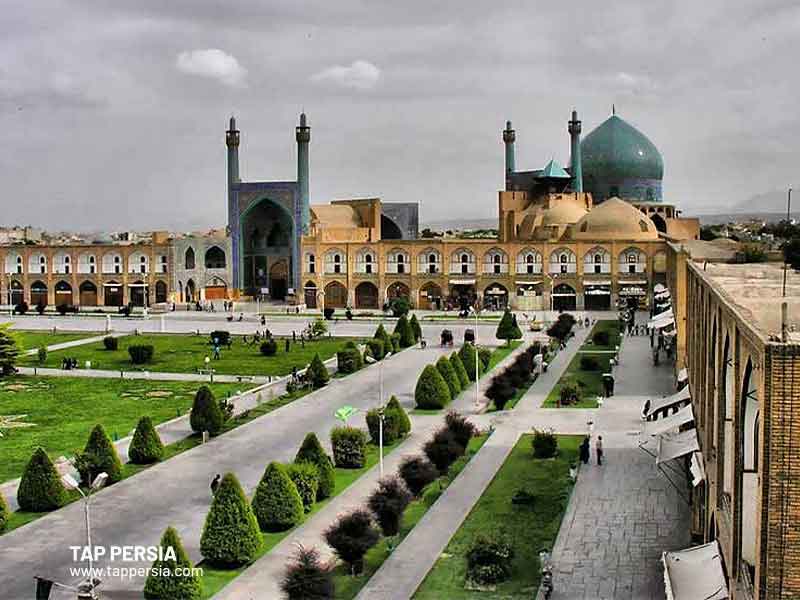
One of the largest, most beautiful, and most magnificent squares in the world is Meidan Emam, a historical square from the Seljuk era in Naqsh-e Jahan. Shah Abbas I ordered it to be built in a rectangle-shaped park called Naqsh-e Jahan.
This is the second-largest square built in the Isfahani architectural design. Four notable architectural structures that were all built around the same time are the Emam Historical Mosque in the south, Sheikh Lotf Allah Mosque in the east, Li Qpu Palace in the west, and Qeysarie Gate in the north of the plaza. This place should be in clude in the list of visiting the best historical places in Iran.
Pasargadae
The Kourosh (Cyrus) shrine lies 600 meters to the northeast of this castle. This palace has a 2,620 square meter space, a great hall in the center with eight columns, four terraces pointing in different directions, and two chambers in the corners. The Pasargadae complex, which consists of a sizable hall with eight columns, sits to the east of the palace.
The white stone irrigation canals in Pasargadae are one of the distinguishing features of this historical place. Additional artifacts, some of which have been classified as national cultural sites, are also scattered around the province. These include the Achaemenian Dynasty Ruins in Saravan Village, the Sassanian Palace in Sarvestan that has been rebuilt and dates to the reign of Bahram Gour (420 AD), the Dokhtar Palace in Rastaq Village from the third century AD, and the Ardeshir Babakan Palace (Marvdasht).
Soltaniyeh, Zanjan
The Dome of Soltaniyeh is the tomb of Öljaitü which was built between 1302 and 1312 AD in Soltaniyeh City (the capital of the Ilkhanids) and is regarded as a significant example of Iranian Islamic architecture and Azeri style architecture.
The Cathedral of Saint Mary of the Flowers in Florence bears witness to the influence of one of the most significant instances of Ilkhanid architecture, the Dome of Soltaniyeh, which has had a significant impact on historical landmarks and architecture across the world.
The Dome of Soltaniyeh is the third biggest dome in the world, behind the Dome of the Cathedral of Saint Mary of the Flowers in Italy and the Dome of Hagia Sophia in Turkey.
Shushtar Historical Hydraulic System
The Shushtar Historical Hydraulic System is a collection of interconnected bridges, canals, mills, dams, waterfalls, and enormous water-conducting tunnels. From the Achaemenid to the Sassanid eras, they were utilized to maximize the usage of water. The Shushtar Waterfalls and Mills Complex was constructed alongside “the Gerger River,” one of the engineering wonders of antiquity.
Ardeshir Babakan, the Sassanid ruler, is supposed to have ordered the artificial construction of the Gerger River during his rule. The Shushtar Waterfalls and Mills Complex is a remarkable work of engineering and technology seen in one of Iran’s historical places. This place is easily one of the best and most beautiful historical places in Iran.
Which City Has the Most Historic Places in Iran?
Easily at the top of the list of sites to see in Iran is Persepolis. It is perhaps Iran’s most popular tourist site. And many people initially travel to Iran for the purpose of seeing this wonderful historical place up close.
What is the oldest place in Iran?
The Iranian plateau’s southwestern and western regions took part in the customary Ancient Near East with Elam (3200 – 539 BC), making it Iran’s oldest historical place.
What holy sites are in Iran?
These famous Iranian historical places for worship and prayers include the Chapel of Chupan, the Imam Reza Shrine in Mashhad, the Fatima Masumeh Shrine in Qom, the Zoroastrian Fire Temple of Chak-Chak, and the St. Stepanos Monastery.
How many World Heritage sites are in Iran?
Iran is one of the nations that have the most historical places, considered World Heritage Sites. Iran currently has 56 properties on UNESCO’s preliminary list.




Comment (0)